AI in Education: Capstone Project Proposal on Applications & Trends
VerifiedAdded on 2023/06/13
|15
|2736
|126
Project
AI Summary
This capstone project proposal outlines a plan to explore and implement AI-based tutoring systems within a university setting. It identifies the problem domain as the need to enhance education delivery through AI, focusing on various learning scenarios and knowledge acquisition methods. The proposal details the purpose and justification for using AI to create collaborative learning environments and improve student engagement. Research questions address the components of existing tutoring systems, student learning models, and the potential benefits of AI technologies. The methodology involves a soft systems development approach, utilizing an incremental agile development methodology for its flexibility. Data collection includes literature reviews and interviews with students and tutors. The project plan outlines deliverables, work breakdown structure, risk analysis, and a Gantt chart, aiming to develop AI modules that cater to different learning paths and capabilities, ultimately enhancing the university's educational offerings. Desklib provides access to similar solved assignments and project proposals to aid students in their academic endeavors.
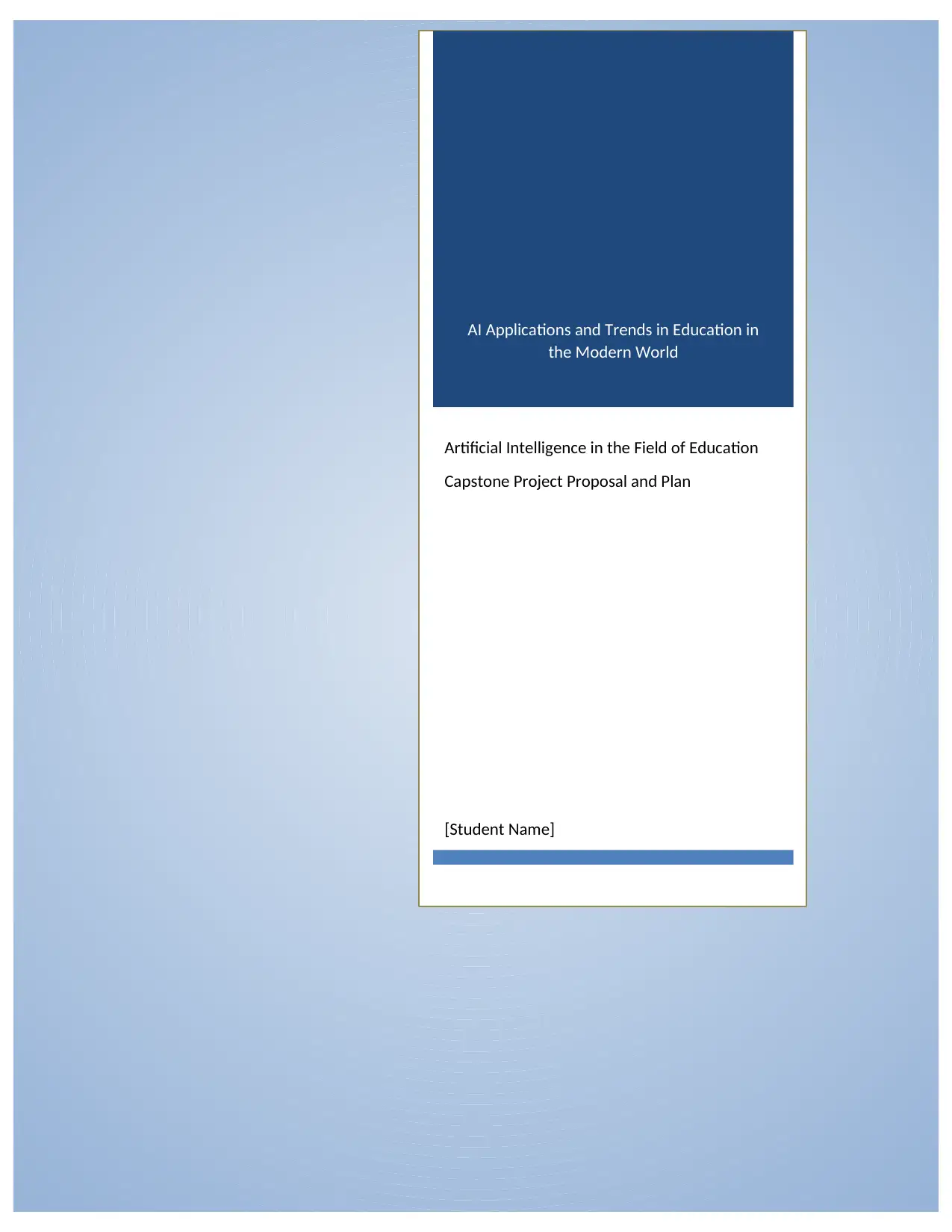
AI Applications and Trends in Education in
the Modern World
Artificial Intelligence in the Field of Education
Capstone Project Proposal and Plan
[Student Name]
the Modern World
Artificial Intelligence in the Field of Education
Capstone Project Proposal and Plan
[Student Name]
Paraphrase This Document
Need a fresh take? Get an instant paraphrase of this document with our AI Paraphraser

2
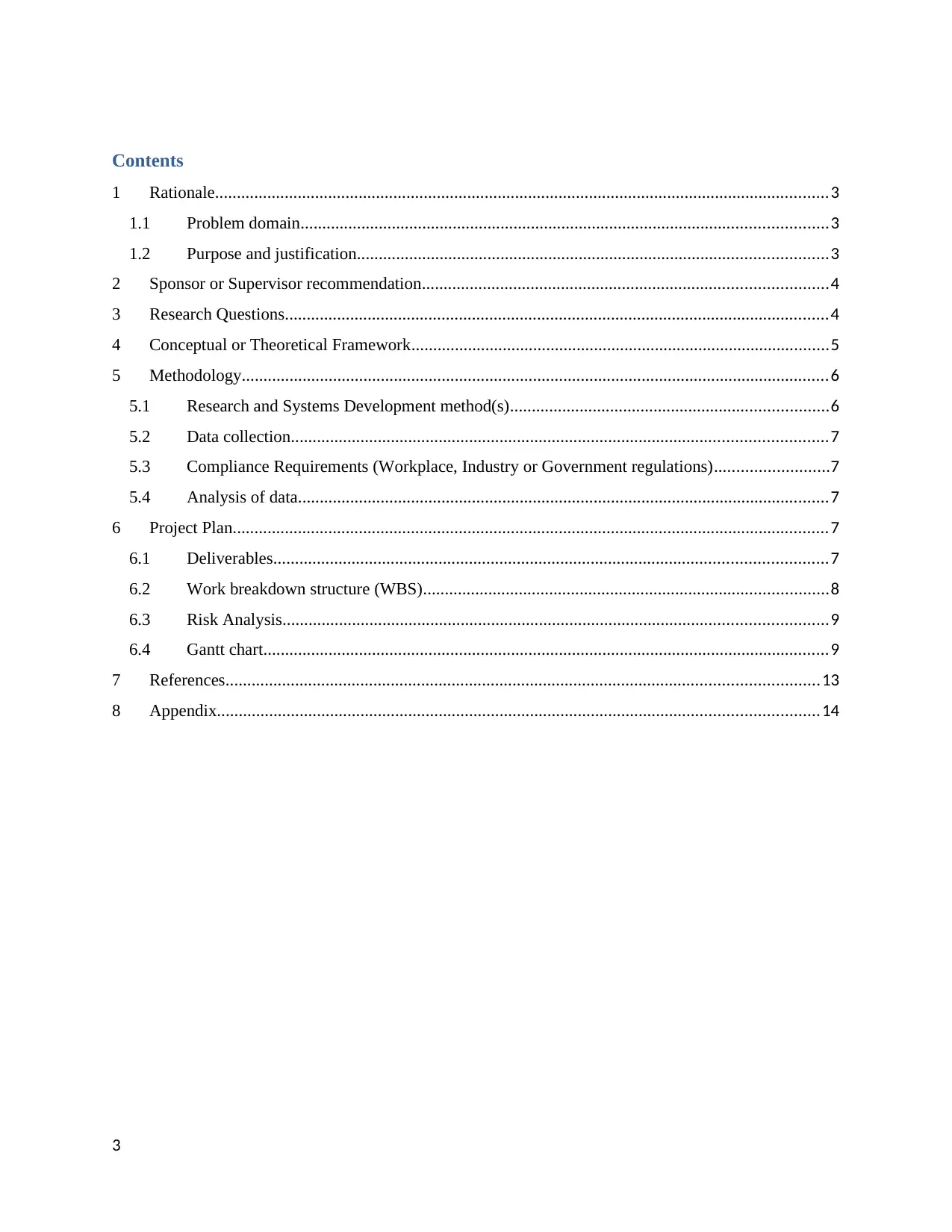
Contents
1 Rationale.............................................................................................................................................3
1.1 Problem domain.........................................................................................................................3
1.2 Purpose and justification............................................................................................................3
2 Sponsor or Supervisor recommendation.............................................................................................4
3 Research Questions.............................................................................................................................4
4 Conceptual or Theoretical Framework................................................................................................5
5 Methodology.......................................................................................................................................6
5.1 Research and Systems Development method(s).........................................................................6
5.2 Data collection...........................................................................................................................7
5.3 Compliance Requirements (Workplace, Industry or Government regulations)..........................7
5.4 Analysis of data..........................................................................................................................7
6 Project Plan.........................................................................................................................................7
6.1 Deliverables...............................................................................................................................7
6.2 Work breakdown structure (WBS).............................................................................................8
6.3 Risk Analysis.............................................................................................................................9
6.4 Gantt chart..................................................................................................................................9
7 References........................................................................................................................................13
8 Appendix..........................................................................................................................................14
3
1 Rationale.............................................................................................................................................3
1.1 Problem domain.........................................................................................................................3
1.2 Purpose and justification............................................................................................................3
2 Sponsor or Supervisor recommendation.............................................................................................4
3 Research Questions.............................................................................................................................4
4 Conceptual or Theoretical Framework................................................................................................5
5 Methodology.......................................................................................................................................6
5.1 Research and Systems Development method(s).........................................................................6
5.2 Data collection...........................................................................................................................7
5.3 Compliance Requirements (Workplace, Industry or Government regulations)..........................7
5.4 Analysis of data..........................................................................................................................7
6 Project Plan.........................................................................................................................................7
6.1 Deliverables...............................................................................................................................7
6.2 Work breakdown structure (WBS).............................................................................................8
6.3 Risk Analysis.............................................................................................................................9
6.4 Gantt chart..................................................................................................................................9
7 References........................................................................................................................................13
8 Appendix..........................................................................................................................................14
3
⊘ This is a preview!⊘
Do you want full access?
Subscribe today to unlock all pages.

Trusted by 1+ million students worldwide
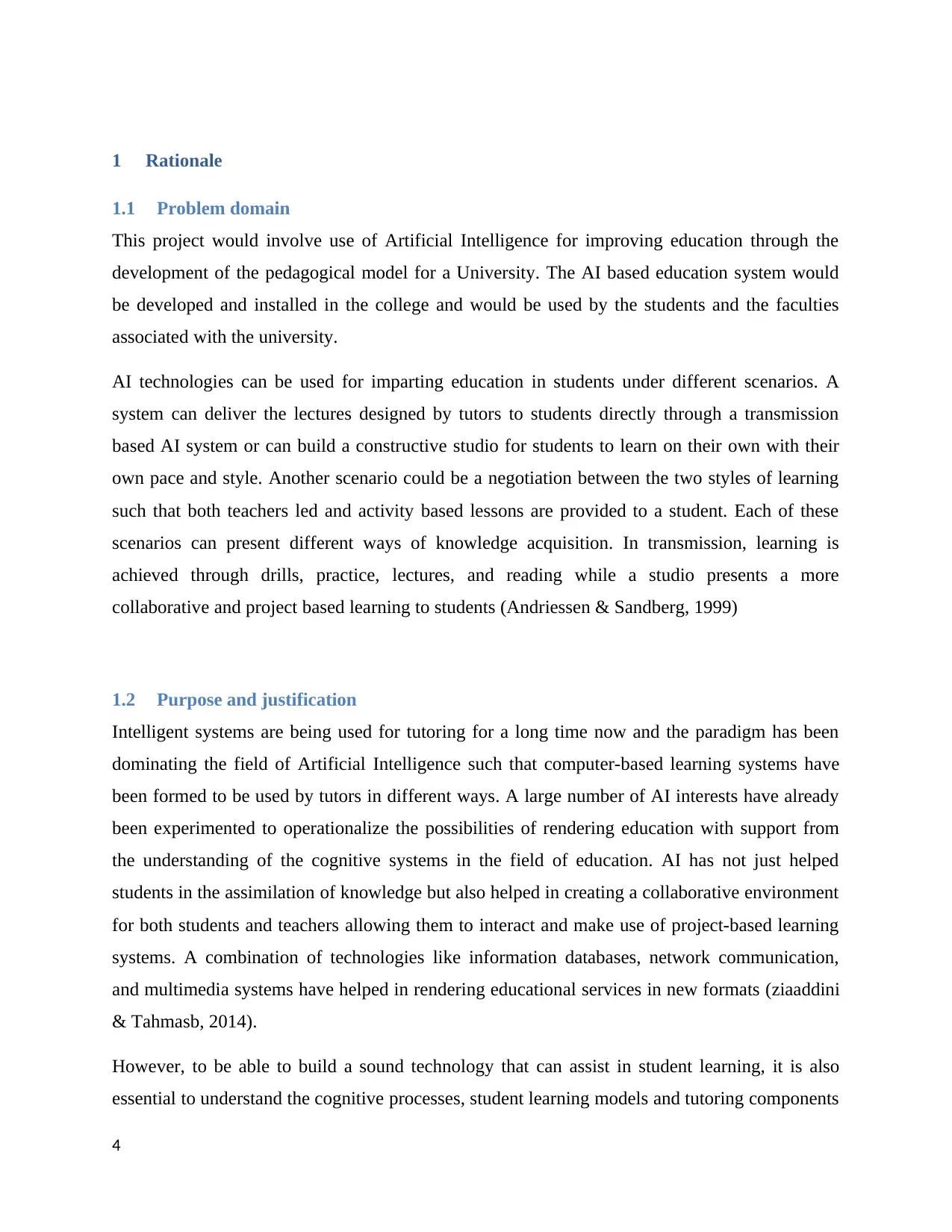
1 Rationale
1.1 Problem domain
This project would involve use of Artificial Intelligence for improving education through the
development of the pedagogical model for a University. The AI based education system would
be developed and installed in the college and would be used by the students and the faculties
associated with the university.
AI technologies can be used for imparting education in students under different scenarios. A
system can deliver the lectures designed by tutors to students directly through a transmission
based AI system or can build a constructive studio for students to learn on their own with their
own pace and style. Another scenario could be a negotiation between the two styles of learning
such that both teachers led and activity based lessons are provided to a student. Each of these
scenarios can present different ways of knowledge acquisition. In transmission, learning is
achieved through drills, practice, lectures, and reading while a studio presents a more
collaborative and project based learning to students (Andriessen & Sandberg, 1999)
1.2 Purpose and justification
Intelligent systems are being used for tutoring for a long time now and the paradigm has been
dominating the field of Artificial Intelligence such that computer-based learning systems have
been formed to be used by tutors in different ways. A large number of AI interests have already
been experimented to operationalize the possibilities of rendering education with support from
the understanding of the cognitive systems in the field of education. AI has not just helped
students in the assimilation of knowledge but also helped in creating a collaborative environment
for both students and teachers allowing them to interact and make use of project-based learning
systems. A combination of technologies like information databases, network communication,
and multimedia systems have helped in rendering educational services in new formats (ziaaddini
& Tahmasb, 2014).
However, to be able to build a sound technology that can assist in student learning, it is also
essential to understand the cognitive processes, student learning models and tutoring components
4
1.1 Problem domain
This project would involve use of Artificial Intelligence for improving education through the
development of the pedagogical model for a University. The AI based education system would
be developed and installed in the college and would be used by the students and the faculties
associated with the university.
AI technologies can be used for imparting education in students under different scenarios. A
system can deliver the lectures designed by tutors to students directly through a transmission
based AI system or can build a constructive studio for students to learn on their own with their
own pace and style. Another scenario could be a negotiation between the two styles of learning
such that both teachers led and activity based lessons are provided to a student. Each of these
scenarios can present different ways of knowledge acquisition. In transmission, learning is
achieved through drills, practice, lectures, and reading while a studio presents a more
collaborative and project based learning to students (Andriessen & Sandberg, 1999)
1.2 Purpose and justification
Intelligent systems are being used for tutoring for a long time now and the paradigm has been
dominating the field of Artificial Intelligence such that computer-based learning systems have
been formed to be used by tutors in different ways. A large number of AI interests have already
been experimented to operationalize the possibilities of rendering education with support from
the understanding of the cognitive systems in the field of education. AI has not just helped
students in the assimilation of knowledge but also helped in creating a collaborative environment
for both students and teachers allowing them to interact and make use of project-based learning
systems. A combination of technologies like information databases, network communication,
and multimedia systems have helped in rendering educational services in new formats (ziaaddini
& Tahmasb, 2014).
However, to be able to build a sound technology that can assist in student learning, it is also
essential to understand the cognitive processes, student learning models and tutoring components
4
Paraphrase This Document
Need a fresh take? Get an instant paraphrase of this document with our AI Paraphraser

as they could be used for the development of modules in the AI setting. This research would
begin to explore these areas of education to determine the possibilities of developing an AI based
tutoring solution which would benefit students of the university in the long run by making
education more engaging and fun for them (BLANCHARD, VOLFSON, HONG, & LAJOIE,
2005).
2 Sponsor or Supervisor recommendation
The university management would be the sponsor for this research and thus, would provide the
needed funds for its execution that includes research, development of software modules, testing,
and installation of the system in the campus. With the new AI system installed for assisting
student learning, the college is expected to receive following benefits:
Students would be able to receive learning even off site which would allow college to
extend their services to more students who may not be attending lectures in the college
The new formats such as multimedia systems would make the learning more engaging for
students and thus, they would have their interests increased in learning
Collaborative AI systems would allow students to work in collaboration with each other
and execute projects for practical lessons
The new system would also provide support to the tutors who could deliver lectures and
other materials to students through the system as well as build plans for their support
(Becker, 2017)
3 Research Questions
The aim of the current research is to understand how pedagogical systems work in a
university and explore the possibilities of development of an AI based tutoring system for
the university to enhance its education delivery system.
The study would be answering following research questions:
What are the components of a tutoring system used in the university?
What is the student learning model used in the university?
What kind of AI technologies are available to be used in the education system?
How would AI based learning system benefit the university and its students?
5
begin to explore these areas of education to determine the possibilities of developing an AI based
tutoring solution which would benefit students of the university in the long run by making
education more engaging and fun for them (BLANCHARD, VOLFSON, HONG, & LAJOIE,
2005).
2 Sponsor or Supervisor recommendation
The university management would be the sponsor for this research and thus, would provide the
needed funds for its execution that includes research, development of software modules, testing,
and installation of the system in the campus. With the new AI system installed for assisting
student learning, the college is expected to receive following benefits:
Students would be able to receive learning even off site which would allow college to
extend their services to more students who may not be attending lectures in the college
The new formats such as multimedia systems would make the learning more engaging for
students and thus, they would have their interests increased in learning
Collaborative AI systems would allow students to work in collaboration with each other
and execute projects for practical lessons
The new system would also provide support to the tutors who could deliver lectures and
other materials to students through the system as well as build plans for their support
(Becker, 2017)
3 Research Questions
The aim of the current research is to understand how pedagogical systems work in a
university and explore the possibilities of development of an AI based tutoring system for
the university to enhance its education delivery system.
The study would be answering following research questions:
What are the components of a tutoring system used in the university?
What is the student learning model used in the university?
What kind of AI technologies are available to be used in the education system?
How would AI based learning system benefit the university and its students?
5
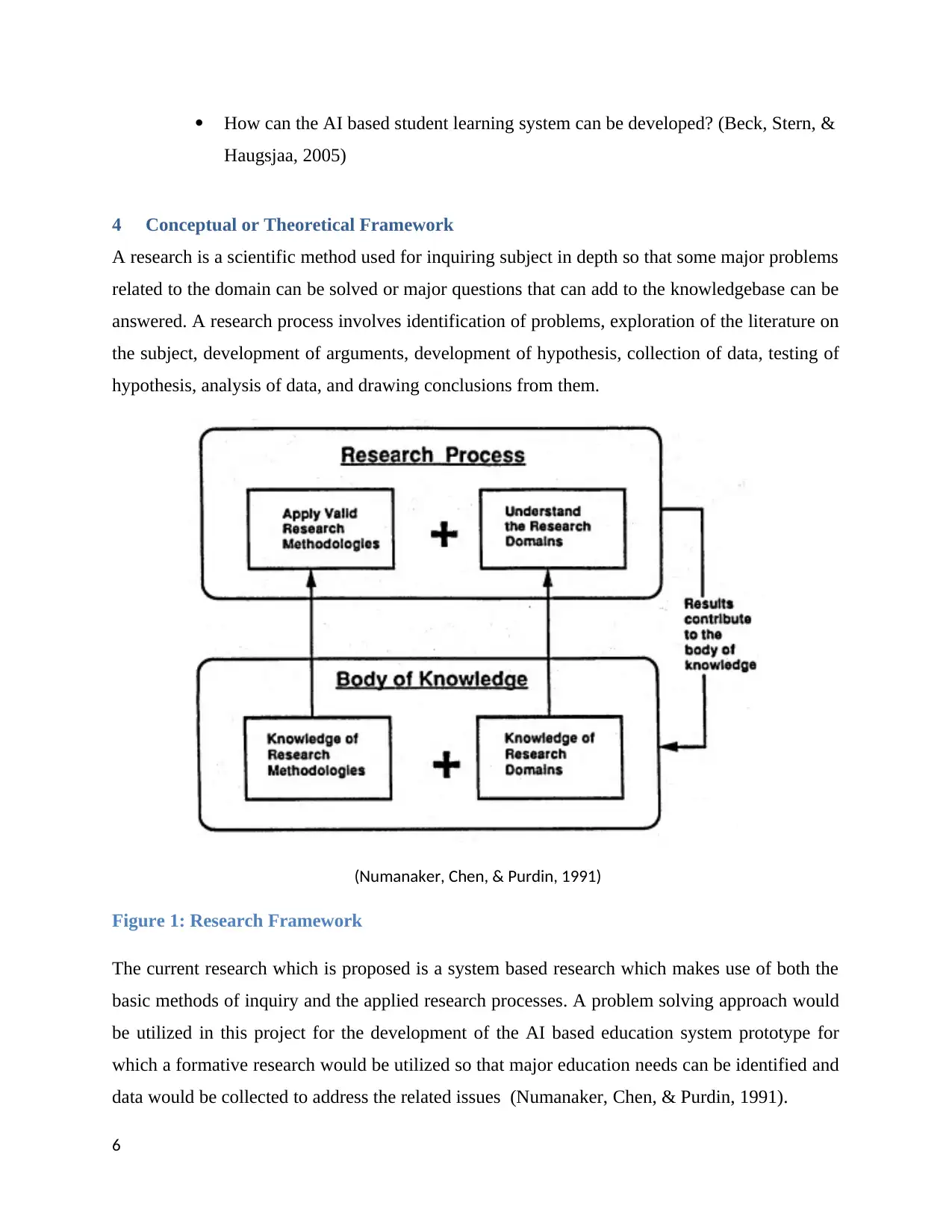
How can the AI based student learning system can be developed? (Beck, Stern, &
Haugsjaa, 2005)
4 Conceptual or Theoretical Framework
A research is a scientific method used for inquiring subject in depth so that some major problems
related to the domain can be solved or major questions that can add to the knowledgebase can be
answered. A research process involves identification of problems, exploration of the literature on
the subject, development of arguments, development of hypothesis, collection of data, testing of
hypothesis, analysis of data, and drawing conclusions from them.
(Numanaker, Chen, & Purdin, 1991)
Figure 1: Research Framework
The current research which is proposed is a system based research which makes use of both the
basic methods of inquiry and the applied research processes. A problem solving approach would
be utilized in this project for the development of the AI based education system prototype for
which a formative research would be utilized so that major education needs can be identified and
data would be collected to address the related issues (Numanaker, Chen, & Purdin, 1991).
6
Haugsjaa, 2005)
4 Conceptual or Theoretical Framework
A research is a scientific method used for inquiring subject in depth so that some major problems
related to the domain can be solved or major questions that can add to the knowledgebase can be
answered. A research process involves identification of problems, exploration of the literature on
the subject, development of arguments, development of hypothesis, collection of data, testing of
hypothesis, analysis of data, and drawing conclusions from them.
(Numanaker, Chen, & Purdin, 1991)
Figure 1: Research Framework
The current research which is proposed is a system based research which makes use of both the
basic methods of inquiry and the applied research processes. A problem solving approach would
be utilized in this project for the development of the AI based education system prototype for
which a formative research would be utilized so that major education needs can be identified and
data would be collected to address the related issues (Numanaker, Chen, & Purdin, 1991).
6
⊘ This is a preview!⊘
Do you want full access?
Subscribe today to unlock all pages.

Trusted by 1+ million students worldwide
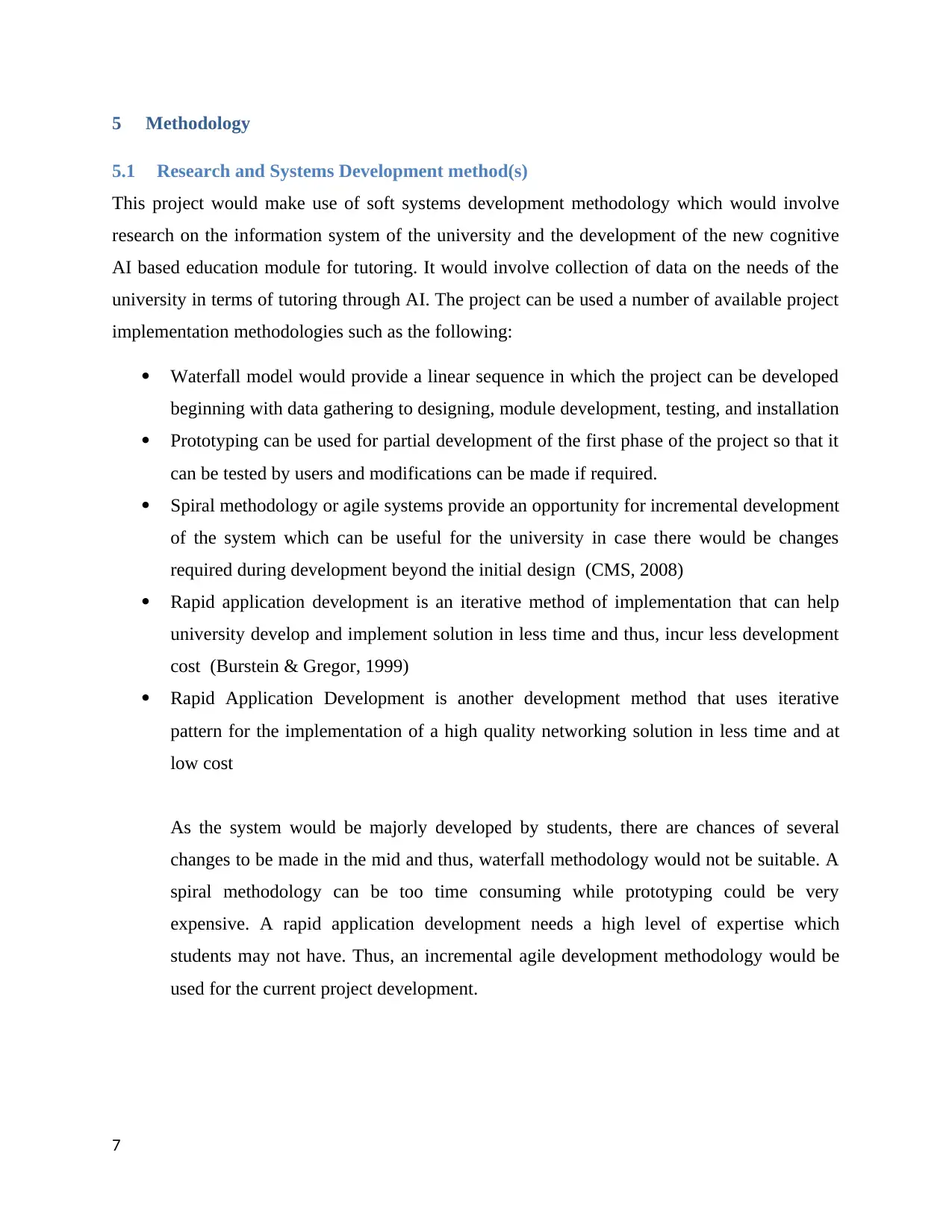
5 Methodology
5.1 Research and Systems Development method(s)
This project would make use of soft systems development methodology which would involve
research on the information system of the university and the development of the new cognitive
AI based education module for tutoring. It would involve collection of data on the needs of the
university in terms of tutoring through AI. The project can be used a number of available project
implementation methodologies such as the following:
Waterfall model would provide a linear sequence in which the project can be developed
beginning with data gathering to designing, module development, testing, and installation
Prototyping can be used for partial development of the first phase of the project so that it
can be tested by users and modifications can be made if required.
Spiral methodology or agile systems provide an opportunity for incremental development
of the system which can be useful for the university in case there would be changes
required during development beyond the initial design (CMS, 2008)
Rapid application development is an iterative method of implementation that can help
university develop and implement solution in less time and thus, incur less development
cost (Burstein & Gregor, 1999)
Rapid Application Development is another development method that uses iterative
pattern for the implementation of a high quality networking solution in less time and at
low cost
As the system would be majorly developed by students, there are chances of several
changes to be made in the mid and thus, waterfall methodology would not be suitable. A
spiral methodology can be too time consuming while prototyping could be very
expensive. A rapid application development needs a high level of expertise which
students may not have. Thus, an incremental agile development methodology would be
used for the current project development.
7
5.1 Research and Systems Development method(s)
This project would make use of soft systems development methodology which would involve
research on the information system of the university and the development of the new cognitive
AI based education module for tutoring. It would involve collection of data on the needs of the
university in terms of tutoring through AI. The project can be used a number of available project
implementation methodologies such as the following:
Waterfall model would provide a linear sequence in which the project can be developed
beginning with data gathering to designing, module development, testing, and installation
Prototyping can be used for partial development of the first phase of the project so that it
can be tested by users and modifications can be made if required.
Spiral methodology or agile systems provide an opportunity for incremental development
of the system which can be useful for the university in case there would be changes
required during development beyond the initial design (CMS, 2008)
Rapid application development is an iterative method of implementation that can help
university develop and implement solution in less time and thus, incur less development
cost (Burstein & Gregor, 1999)
Rapid Application Development is another development method that uses iterative
pattern for the implementation of a high quality networking solution in less time and at
low cost
As the system would be majorly developed by students, there are chances of several
changes to be made in the mid and thus, waterfall methodology would not be suitable. A
spiral methodology can be too time consuming while prototyping could be very
expensive. A rapid application development needs a high level of expertise which
students may not have. Thus, an incremental agile development methodology would be
used for the current project development.
7
Paraphrase This Document
Need a fresh take? Get an instant paraphrase of this document with our AI Paraphraser
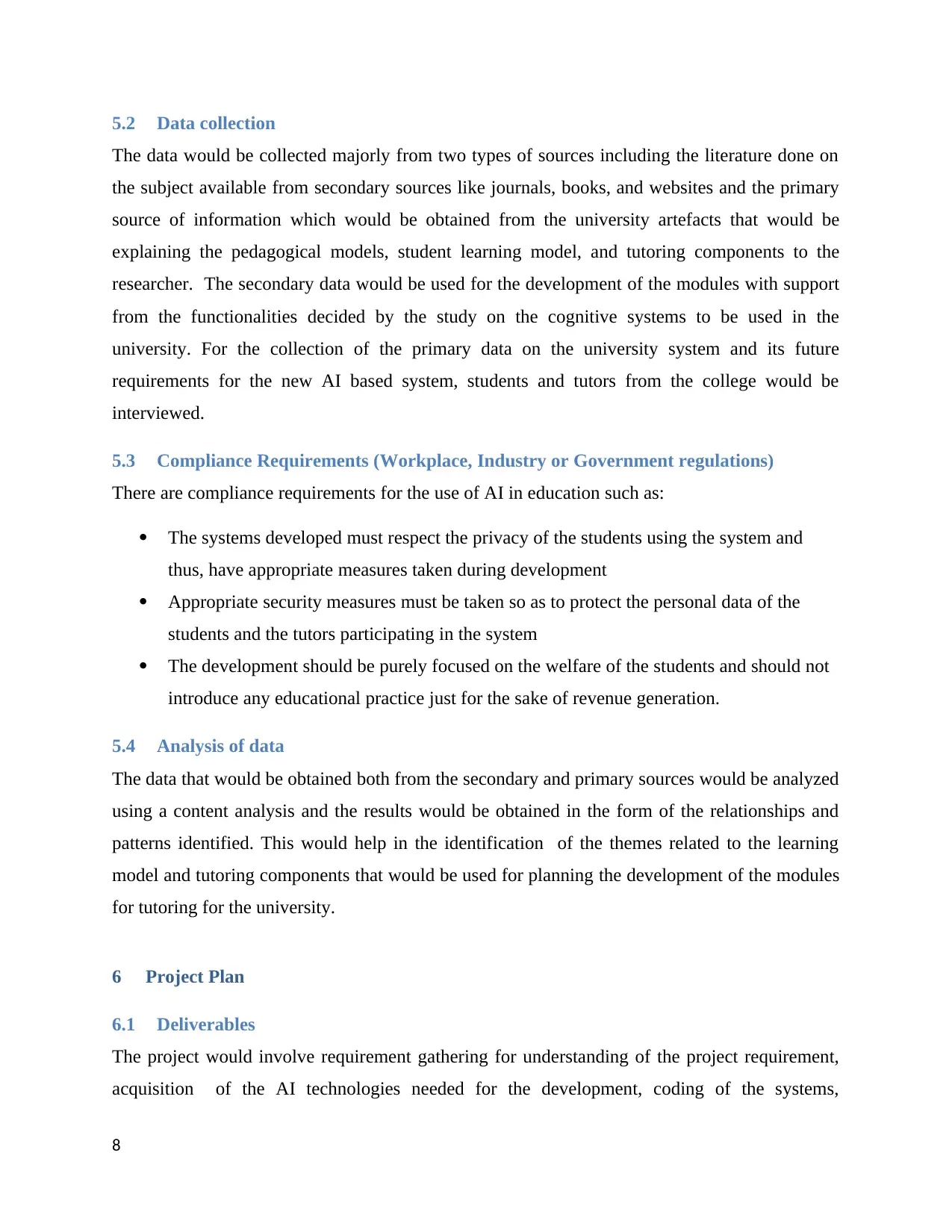
5.2 Data collection
The data would be collected majorly from two types of sources including the literature done on
the subject available from secondary sources like journals, books, and websites and the primary
source of information which would be obtained from the university artefacts that would be
explaining the pedagogical models, student learning model, and tutoring components to the
researcher. The secondary data would be used for the development of the modules with support
from the functionalities decided by the study on the cognitive systems to be used in the
university. For the collection of the primary data on the university system and its future
requirements for the new AI based system, students and tutors from the college would be
interviewed.
5.3 Compliance Requirements (Workplace, Industry or Government regulations)
There are compliance requirements for the use of AI in education such as:
The systems developed must respect the privacy of the students using the system and
thus, have appropriate measures taken during development
Appropriate security measures must be taken so as to protect the personal data of the
students and the tutors participating in the system
The development should be purely focused on the welfare of the students and should not
introduce any educational practice just for the sake of revenue generation.
5.4 Analysis of data
The data that would be obtained both from the secondary and primary sources would be analyzed
using a content analysis and the results would be obtained in the form of the relationships and
patterns identified. This would help in the identification of the themes related to the learning
model and tutoring components that would be used for planning the development of the modules
for tutoring for the university.
6 Project Plan
6.1 Deliverables
The project would involve requirement gathering for understanding of the project requirement,
acquisition of the AI technologies needed for the development, coding of the systems,
8
The data would be collected majorly from two types of sources including the literature done on
the subject available from secondary sources like journals, books, and websites and the primary
source of information which would be obtained from the university artefacts that would be
explaining the pedagogical models, student learning model, and tutoring components to the
researcher. The secondary data would be used for the development of the modules with support
from the functionalities decided by the study on the cognitive systems to be used in the
university. For the collection of the primary data on the university system and its future
requirements for the new AI based system, students and tutors from the college would be
interviewed.
5.3 Compliance Requirements (Workplace, Industry or Government regulations)
There are compliance requirements for the use of AI in education such as:
The systems developed must respect the privacy of the students using the system and
thus, have appropriate measures taken during development
Appropriate security measures must be taken so as to protect the personal data of the
students and the tutors participating in the system
The development should be purely focused on the welfare of the students and should not
introduce any educational practice just for the sake of revenue generation.
5.4 Analysis of data
The data that would be obtained both from the secondary and primary sources would be analyzed
using a content analysis and the results would be obtained in the form of the relationships and
patterns identified. This would help in the identification of the themes related to the learning
model and tutoring components that would be used for planning the development of the modules
for tutoring for the university.
6 Project Plan
6.1 Deliverables
The project would involve requirement gathering for understanding of the project requirement,
acquisition of the AI technologies needed for the development, coding of the systems,
8

development of the tutoring components as modules, testing of the developed system, and
installation of the same in the university for the delivery.
Learning model: This would have the information of the students who are categorized
based on their learning paths and capabilities
Tutoring Components: These would include the student model, knowledge model,
communication model, a pedagogical module, and an expert module
AI Modules: Based on the learning model and the identified tutoring components,
different cognitive learning modules would be developed using AI capabilities.
6.2 Work breakdown structure (WBS)
1.0 Research Project initiation
1.1 Developing scope
1.2 Resource identification
1.3 Roles and responsibilities
2.0 Data Gathering
2.1 University facts
2.1.1 Tutoring components
2.1.2 Student Model
2.2 Research documents
2.3 AI Applications
2.4 University requirements
3.0 Requirement Identification
3.1 Modules
3.2 User requirements
3.3 Functional requirements
3.4 Non-Functional requirements
4.0 Requirement Verification & Validation
4.1 User requirement verification
4.2 User requirement Validation
5.0 Development
9
installation of the same in the university for the delivery.
Learning model: This would have the information of the students who are categorized
based on their learning paths and capabilities
Tutoring Components: These would include the student model, knowledge model,
communication model, a pedagogical module, and an expert module
AI Modules: Based on the learning model and the identified tutoring components,
different cognitive learning modules would be developed using AI capabilities.
6.2 Work breakdown structure (WBS)
1.0 Research Project initiation
1.1 Developing scope
1.2 Resource identification
1.3 Roles and responsibilities
2.0 Data Gathering
2.1 University facts
2.1.1 Tutoring components
2.1.2 Student Model
2.2 Research documents
2.3 AI Applications
2.4 University requirements
3.0 Requirement Identification
3.1 Modules
3.2 User requirements
3.3 Functional requirements
3.4 Non-Functional requirements
4.0 Requirement Verification & Validation
4.1 User requirement verification
4.2 User requirement Validation
5.0 Development
9
⊘ This is a preview!⊘
Do you want full access?
Subscribe today to unlock all pages.

Trusted by 1+ million students worldwide
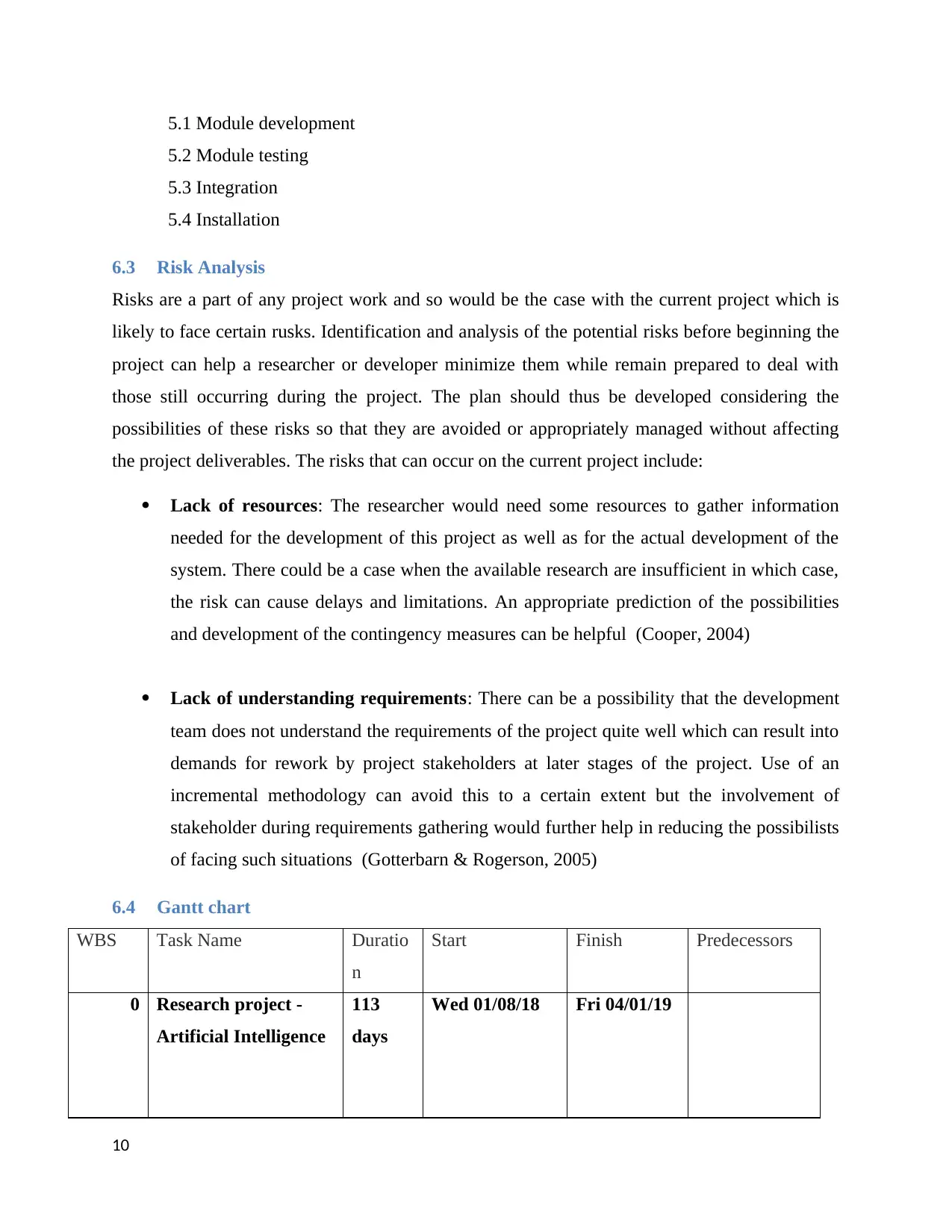
5.1 Module development
5.2 Module testing
5.3 Integration
5.4 Installation
6.3 Risk Analysis
Risks are a part of any project work and so would be the case with the current project which is
likely to face certain rusks. Identification and analysis of the potential risks before beginning the
project can help a researcher or developer minimize them while remain prepared to deal with
those still occurring during the project. The plan should thus be developed considering the
possibilities of these risks so that they are avoided or appropriately managed without affecting
the project deliverables. The risks that can occur on the current project include:
Lack of resources: The researcher would need some resources to gather information
needed for the development of this project as well as for the actual development of the
system. There could be a case when the available research are insufficient in which case,
the risk can cause delays and limitations. An appropriate prediction of the possibilities
and development of the contingency measures can be helpful (Cooper, 2004)
Lack of understanding requirements: There can be a possibility that the development
team does not understand the requirements of the project quite well which can result into
demands for rework by project stakeholders at later stages of the project. Use of an
incremental methodology can avoid this to a certain extent but the involvement of
stakeholder during requirements gathering would further help in reducing the possibilists
of facing such situations (Gotterbarn & Rogerson, 2005)
6.4 Gantt chart
WBS Task Name Duratio
n
Start Finish Predecessors
0 Research project -
Artificial Intelligence
113
days
Wed 01/08/18 Fri 04/01/19
10
5.2 Module testing
5.3 Integration
5.4 Installation
6.3 Risk Analysis
Risks are a part of any project work and so would be the case with the current project which is
likely to face certain rusks. Identification and analysis of the potential risks before beginning the
project can help a researcher or developer minimize them while remain prepared to deal with
those still occurring during the project. The plan should thus be developed considering the
possibilities of these risks so that they are avoided or appropriately managed without affecting
the project deliverables. The risks that can occur on the current project include:
Lack of resources: The researcher would need some resources to gather information
needed for the development of this project as well as for the actual development of the
system. There could be a case when the available research are insufficient in which case,
the risk can cause delays and limitations. An appropriate prediction of the possibilities
and development of the contingency measures can be helpful (Cooper, 2004)
Lack of understanding requirements: There can be a possibility that the development
team does not understand the requirements of the project quite well which can result into
demands for rework by project stakeholders at later stages of the project. Use of an
incremental methodology can avoid this to a certain extent but the involvement of
stakeholder during requirements gathering would further help in reducing the possibilists
of facing such situations (Gotterbarn & Rogerson, 2005)
6.4 Gantt chart
WBS Task Name Duratio
n
Start Finish Predecessors
0 Research project -
Artificial Intelligence
113
days
Wed 01/08/18 Fri 04/01/19
10
Paraphrase This Document
Need a fresh take? Get an instant paraphrase of this document with our AI Paraphraser

1 Research Project
initiation
5 days Wed 01/08/18 Tue 07/08/18
1.1 Developing scope 3 days Wed 01/08/18 Fri 03/08/18
1.2 Resource
identification
3 days Wed 01/08/18 Fri 03/08/18
1.3 Roles and
responsibilities
5 days Wed 01/08/18 Tue 07/08/18
2 Data Gathering 38 days Wed 08/08/18 Fri 28/09/18
2.1 University facts 8 days Wed 08/08/18 Fri 17/08/18
2.1.1 Tutoring
components
8 days Wed 08/08/18 Fri 17/08/18 2,3,4
2.1.2 Student Model 8 days Wed 08/08/18 Fri 17/08/18 2,3,4
2.2 Research
documents
8 days Mon 20/08/18 Wed
29/08/18
7,8
2.3 AI Applications 10 days Thu 30/08/18 Wed
12/09/18
9
2.4 University
requirements
12 days Thu 13/09/18 Fri 28/09/18 10
3 Requirement
Identification
32 days Mon 01/10/18 Tue 13/11/18
11
initiation
5 days Wed 01/08/18 Tue 07/08/18
1.1 Developing scope 3 days Wed 01/08/18 Fri 03/08/18
1.2 Resource
identification
3 days Wed 01/08/18 Fri 03/08/18
1.3 Roles and
responsibilities
5 days Wed 01/08/18 Tue 07/08/18
2 Data Gathering 38 days Wed 08/08/18 Fri 28/09/18
2.1 University facts 8 days Wed 08/08/18 Fri 17/08/18
2.1.1 Tutoring
components
8 days Wed 08/08/18 Fri 17/08/18 2,3,4
2.1.2 Student Model 8 days Wed 08/08/18 Fri 17/08/18 2,3,4
2.2 Research
documents
8 days Mon 20/08/18 Wed
29/08/18
7,8
2.3 AI Applications 10 days Thu 30/08/18 Wed
12/09/18
9
2.4 University
requirements
12 days Thu 13/09/18 Fri 28/09/18 10
3 Requirement
Identification
32 days Mon 01/10/18 Tue 13/11/18
11
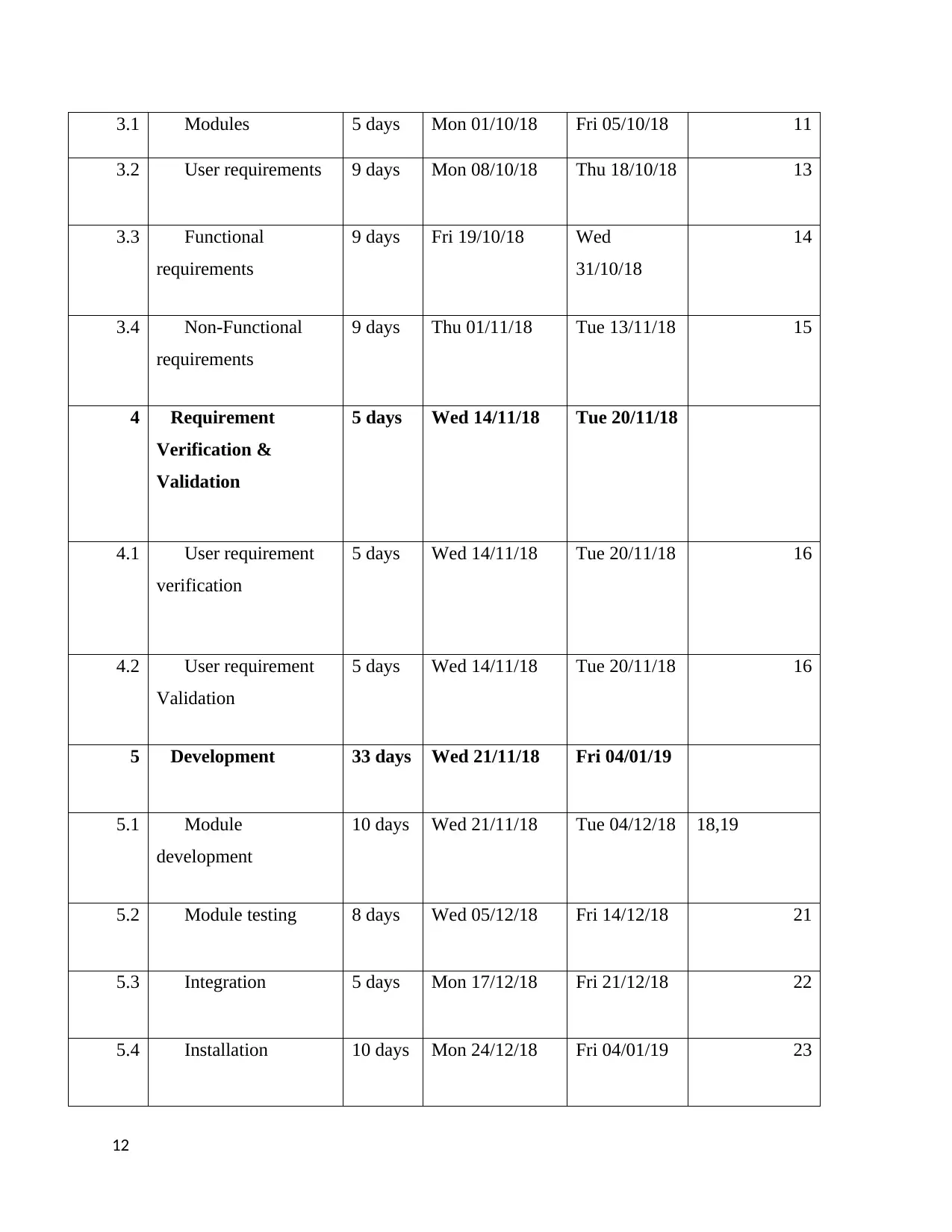
3.1 Modules 5 days Mon 01/10/18 Fri 05/10/18 11
3.2 User requirements 9 days Mon 08/10/18 Thu 18/10/18 13
3.3 Functional
requirements
9 days Fri 19/10/18 Wed
31/10/18
14
3.4 Non-Functional
requirements
9 days Thu 01/11/18 Tue 13/11/18 15
4 Requirement
Verification &
Validation
5 days Wed 14/11/18 Tue 20/11/18
4.1 User requirement
verification
5 days Wed 14/11/18 Tue 20/11/18 16
4.2 User requirement
Validation
5 days Wed 14/11/18 Tue 20/11/18 16
5 Development 33 days Wed 21/11/18 Fri 04/01/19
5.1 Module
development
10 days Wed 21/11/18 Tue 04/12/18 18,19
5.2 Module testing 8 days Wed 05/12/18 Fri 14/12/18 21
5.3 Integration 5 days Mon 17/12/18 Fri 21/12/18 22
5.4 Installation 10 days Mon 24/12/18 Fri 04/01/19 23
12
3.2 User requirements 9 days Mon 08/10/18 Thu 18/10/18 13
3.3 Functional
requirements
9 days Fri 19/10/18 Wed
31/10/18
14
3.4 Non-Functional
requirements
9 days Thu 01/11/18 Tue 13/11/18 15
4 Requirement
Verification &
Validation
5 days Wed 14/11/18 Tue 20/11/18
4.1 User requirement
verification
5 days Wed 14/11/18 Tue 20/11/18 16
4.2 User requirement
Validation
5 days Wed 14/11/18 Tue 20/11/18 16
5 Development 33 days Wed 21/11/18 Fri 04/01/19
5.1 Module
development
10 days Wed 21/11/18 Tue 04/12/18 18,19
5.2 Module testing 8 days Wed 05/12/18 Fri 14/12/18 21
5.3 Integration 5 days Mon 17/12/18 Fri 21/12/18 22
5.4 Installation 10 days Mon 24/12/18 Fri 04/01/19 23
12
⊘ This is a preview!⊘
Do you want full access?
Subscribe today to unlock all pages.

Trusted by 1+ million students worldwide
1 out of 15
Related Documents
Your All-in-One AI-Powered Toolkit for Academic Success.
+13062052269
info@desklib.com
Available 24*7 on WhatsApp / Email
![[object Object]](/_next/static/media/star-bottom.7253800d.svg)
Unlock your academic potential
Copyright © 2020–2025 A2Z Services. All Rights Reserved. Developed and managed by ZUCOL.




